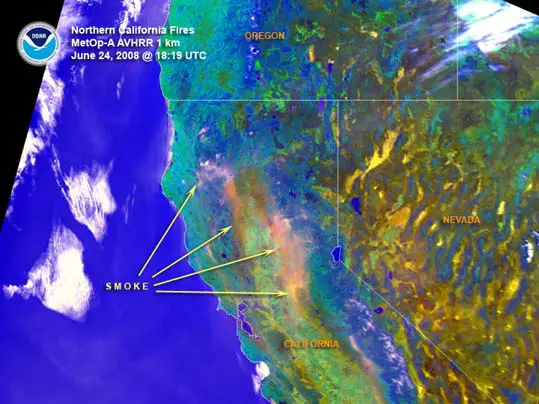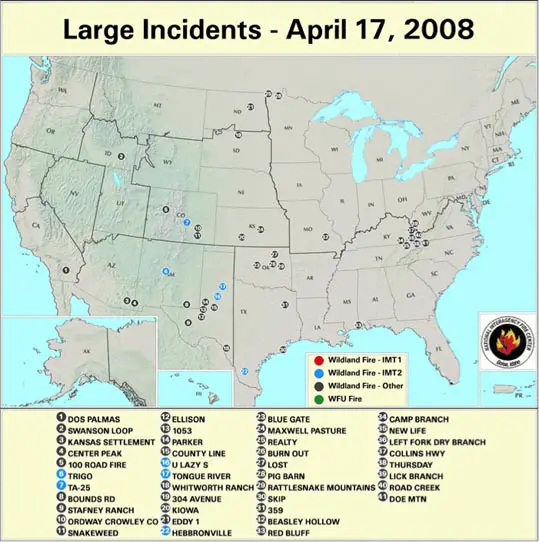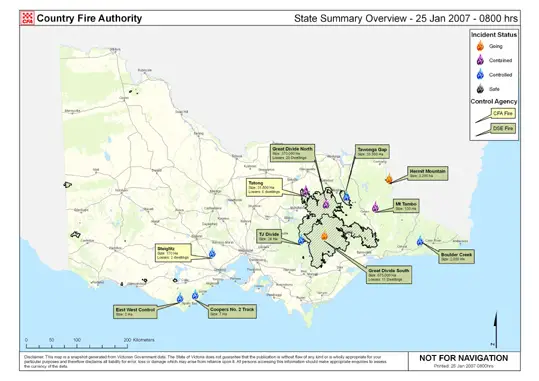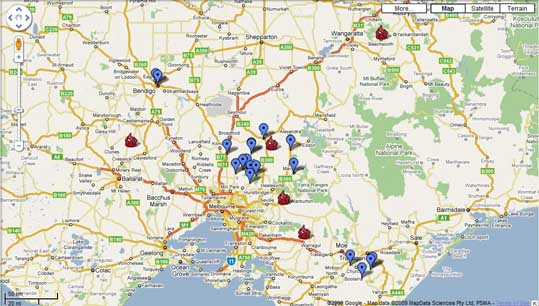On Wednesday 11 Januray 2009, the death toll from severe wildfires in the Australian state of Victoria has risen to 181, with people still in critical conditions in hospital.
The death toll surpasses that from the 1983 Ash Wednesday bushfires, in which 75 people died in Victoria and South Australia , and the Black Friday bushfires of 1939, which killed 71. Over 1,000 homes have been destroyed across the state. Undoubtedly these are the worst bushfires since the beginning of European settlement in Australia.
More than 20 fires continued to burn across Victoria on Sunday after horrific heat and wind on Saturday set the state ablaze. Virtually the entire township of Marysville in the Yarra Valley was destroyed as the East Kilmore and Murrindindi Mill fires merged into a massive 120,000 hectare inferno, now known as the Kinglake Complex(click on the map to see the locations).
There are also 59 fires burning across NSW in Australia. 10 of the fires are burning out of control will not be contained on Sunday due to hot and windy conditions plaguing most of the state.
On Sept 9 2008 severe wildfires swept through the Mozambique provinces of Manica and Sofala killing 49 people, and leaving more than than 2,000 homeless. The fires covered 3 million hectares of land, which were fuelled by high temperatures.
More than 800 fires, sparked by lightning, charred parts of northern California during the last week of June. Just 32 fires burned as much as 110,100 hectares (272,000 acres) of land

Severe wildfires developed across much of the south-central United States during mid-April 2008. In Ordway, Colorado, a wildfire fuelled by 80 km/hr (50 mph or 43 knots) winds, charred nearly 3,602 hectares (8,900 acres) of land and forced all 1,200 residents to evacuate the area. The fire destroyed 8 homes, 24 additional buildings, and was responsible for at least 3 fatalities: 2 volunteer firefighters and a pilot on a firefighting plane battling a blaze.

Severe wildfires in southern California, which started on October 21 2007, forced 950,000 residents to evacuate the area, resulting in the biggest evacuation in Californian history (BBC News). The fires charred 209,200 hectares (517,000 acres), destroyed more than 2,000 homes, killed 7 people and injured 40 others. Seven of southern California’s counties have been declared in a state of emergency by President Bush.
Australia
The severe wildfires prone eastern states of Australia will increasingly feel the impacts of climate change. Australia is experiencing one of its worst droughts in 100 years. As climate change deepens increasingly severe droughts are expected, with more unpredictable weather conditions, including high temperatures, high winds and wildfires. The Tatong fire in the north-east ofVictoria, grew from 19,000 hectares to 33,000 hectares in two days. So far five homes, 20 sheds, 80 livestock and 1,000 hectares of plantations have been lost in the Tatong blaze. Crews fought blazes in sizzling 40+ degree celsius temperatures fanned by hot winds. In a fire sparked by lightning between the towns of Tatong and Myrrhee, southeast of Benalla, 5000ha was destroyed. Over 220 firefighters with 30 trucks and five bulldozers protected property and created containment lines, along with air support. Fire also burned to within 200m of the Mt Buller Alpine Village in Victoria’s northeast. Recent cooler temperatures have provided some relief to communities and fire-fighters, however limited rainfall in some areas means there is still potential for active fire behaviour over the coming days. The total area now burned in Victoria since recent fires began is 1,081,480 ha.

Fires Burning in Victoria, Australia
A fire in New South Wales has burned out more than 23,000 hectares about 40km north of Dubbo, in the Goonoo Community Conservation Area. Firefighters also fought severe wildfires threatening hundreds of homes and properties on the NSW Central Coast. A total of 120 firetrucks and more than 750 firefighters battled to stop the 30-metre flames from closing in on homes at east Kariong. These fires continued on from December 2006 where more than 70 fires were burnt throughout NSW, with 2,500 firefighters working to establish containment lines. Massive bush fires also raged out of control in the Blue Mountains area West of Sydney.
Lightning storms across Tasmania caused approximately twenty five fires from Marrawah in the North West to Copping in the south with the bulk concentrated in the North West. Fire crews working through the night extinguished the majority of the fires and to contain fires at Campania, Melrose and Mathinna. Forestry Tasmania and the Parks and Wildlife Service have deployed firefighting crews to fires in remote areas in the North West. More than a dozen houses burned in small towns along the east coast of Tasmania when bush fires hit the island in December 2006.

